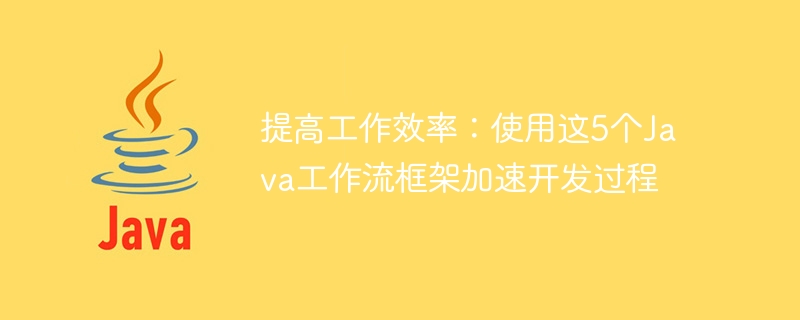Home >Java >javaTutorial >5 Java workflow frameworks: secret weapons to improve development efficiency
5 Java workflow frameworks: secret weapons to improve development efficiency
- 王林Original
- 2023-12-27 12:08:261185browse

In the modern fast-paced work environment, improving work efficiency is the goal pursued by everyone. For Java developers, using an efficient workflow framework is an effective way to speed up the development process. This article will introduce 5 excellent Java workflow frameworks to help developers improve work efficiency.
- Activiti
Activiti is a mature and widely used Java workflow framework. It provides complete workflow management functions, including process definition, process instance management, task management, etc. Activiti supports the BPMN 2.0 standard, allowing developers to easily model and design processes. In addition, Activiti also provides a wealth of APIs and plug-ins to facilitate developers to expand and customize development according to their needs. - Camunda
Camunda is a powerful and flexible Java workflow framework based on Activiti, providing richer functions and better performance. Camunda supports the BPMN 2.0 standard and supports more process modeling and customization capabilities through extended APIs and plug-ins. Camunda also provides powerful analysis and monitoring tools to help developers gain in-depth understanding of workflow execution and performance. - Spring Workflow
Spring Workflow is a lightweight workflow framework based on the Spring framework. It provides simple and easy-to-use process definition and process instance management functions. Spring Workflow uses simple annotations and configurations to enable developers to quickly define and configure workflows. In addition, Spring Workflow is closely integrated with other Spring modules (such as Spring Boot and Spring Security), making it convenient for developers to develop full-stack applications. - jBPM
jBPM is a powerful Java workflow framework that provides flexible process definition and process execution functions. jBPM supports the BPMN 2.0 standard and provides a visual process designer, allowing developers to intuitively conduct process modeling and design. jBPM also supports integration with other Java frameworks (such as Spring and Hibernate) to facilitate developers to use it in actual projects. - Apache Oozie
Apache Oozie is a Java workflow framework for the big data field, mainly used to coordinate and execute large-scale data processing workflows. Oozie supports multiple process definition languages (such as BPMN and Apache Pig language), and provides a rich set of actions and control nodes to facilitate developers to perform complex data processing operations. Oozie also supports seamless integration with Hadoop and other big data ecosystems, meeting the actual needs of big data processing.
In short, using the Java workflow framework can help developers improve work efficiency, simplify process definition and management, and accelerate the development process. This article introduces 5 excellent Java workflow frameworks, which are Activiti, Camunda, Spring Workflow, jBPM and Apache Oozie. Developers can choose the appropriate framework based on project needs and personal preferences, improve work efficiency, and better cope with work challenges.
The above is the detailed content of 5 Java workflow frameworks: secret weapons to improve development efficiency. For more information, please follow other related articles on the PHP Chinese website!

